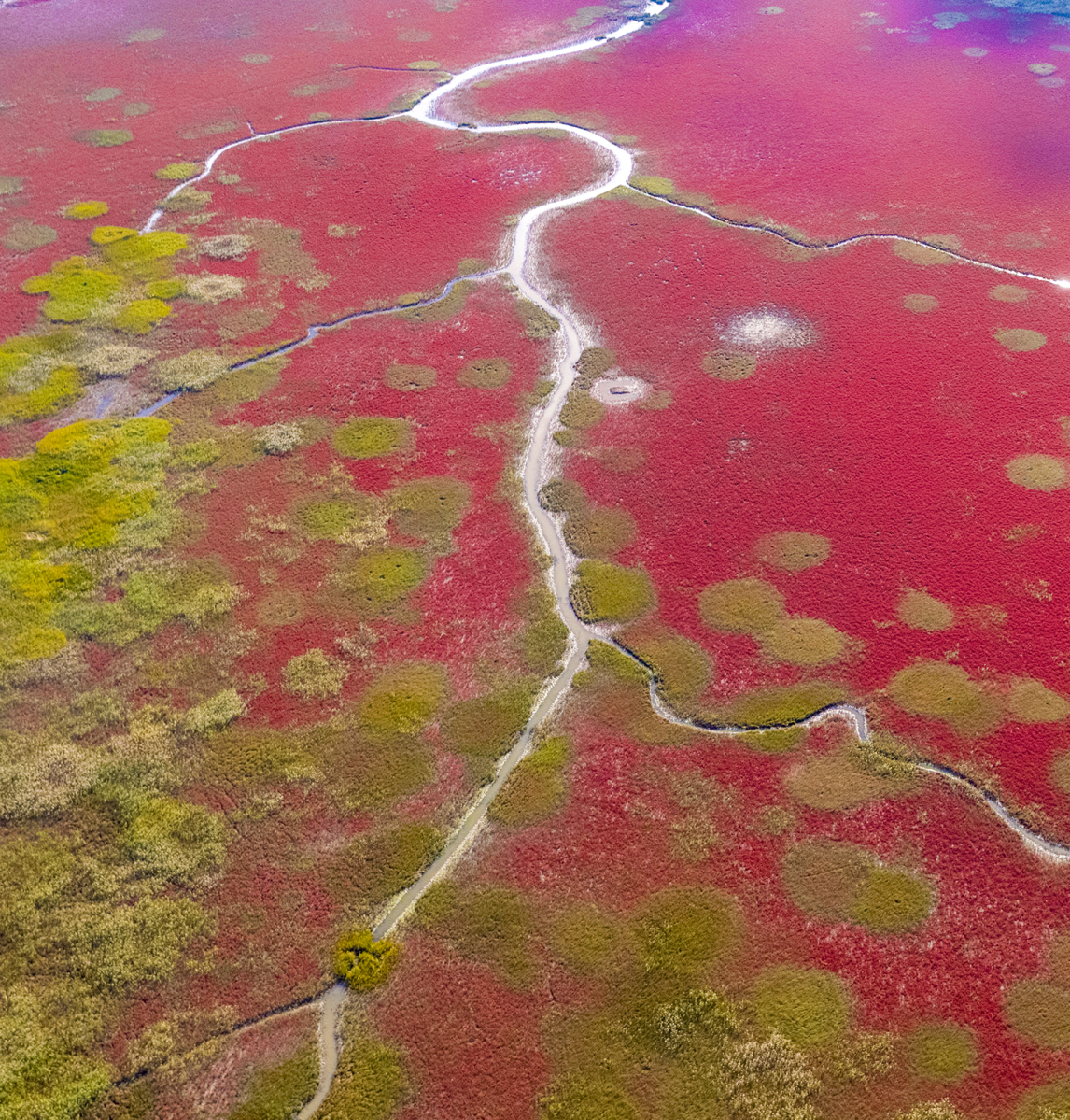The cover image for our October issue features a typical saltmarsh landscape along the Yellow sea coast, China. This image relates to the article: Inferring plant-plant interactions using remote sensing, by Chen et al. Here, authors Bin Chen, Quan-Xing Liu and Chi Xu tell the story behind the image.
Just like us humans, plants also have friends and enemies. ‘Friendship’ is invaluable in harsh environments. For instance, seedlings would quickly die out in hot, dry conditions without neighboring adult trees helping alleviate water stress – coined ‘nurse plant effect’, this is a classic example of positive plant-plant interactions. On the other hand, more often we see ‘hostility’ in nature, in the sense that competition for resources is ubiquitous between coexisting plants. Bin Chen has been doing experiments on plant roots for years, and has made many interesting findings: when paired plants sense the presence of each other, an ‘armor race’ is often triggered – they both over-invest in root growth in order to scramble as much soil nutrients as possible from their opponents, even though this will undermine their overall fitness. Now, positive and negative plant-plant interactions have become a core interest for Bin. Around these interactions there have been a myriad of fascinating stories. They are key to understanding community assembly, ecosystem functioning, evolutionary processes, and many other fundamental questions.
While one can use sophisticated experiments to study plant-plant interactions under well-controlled conditions, it is difficult to say how often and how strong these interactions are in natural ecosystems, especially at large spatial scales. For instance, would it be possible to tell if co-existing plants are mostly friendly or hostile to one another, just from a glimpse of the landscape, like in the cover image?
Equipped with state-of-the-art remote sensing technologies and theoretical models, ecologists can now make use of spatial information to effectively infer positive and negative interactions between plants across a wide range of scales. In the review article related to the cover image, Bin and colleagues provide a synthesis of the progress and prospects of inferring plant-plant interactions using remote sensing tools at individual, community, and landscape scales.
Among the most interesting studies are how ecologists search for interaction signals from landscape vegetation patterns. In some special cases, the emergence of particular vegetation patterns could immediately inform not only the existence, but also the operating scales of facilitation and competition between plants. The most studied example may be ‘Turing patterns’ (named after Alan Turing, the founder of computer science) characterized by spatially periodic patterns resembling spots, gaps, stripes, or labyrinths. Theory suggests that these patterns are attributed to short-range facilitation in coupling with long-range competition between plants (and other organisms), known as ‘scale-dependent feedback’.

This mechanism of spatial self-organization is supported by much field evidence. Quan-Xing Liu has conducted transplanted experiments on Dutch and Chinese coastal mudflats subject to strong wave impacts. He found that saltmarsh plants (such as cordgrass Spartina anglica or sedge Scirpus mariqueter) survived better when transplanted into existing vegetation patches (a small-scale positive interaction), but were wiped out by waves more easily when transplanted on the fringe of the patches (a larger-scale negative interaction). Inspired by the coastal work, Quan-Xing is delving into more diverse spatial patterns across a wide range of systems. Some even go beyond the Earth. Using photos taken by the Curiosity Rover, he is now studying the patterned ground on Mars to infer interactions between stones and sands.
‘Fairy circles’ are another class of striking vegetation patterns. The spontaneous ring-like vegetation patterns found in Namibian and Australian deserts have invoked much curiosity. Some have been attributed to termite herbivory, or competition for soil water. Fairy circles have also been found in coastal saltmarshes. Quan-Xing, with an international team, used drone images, nitrogen addition experiments, and mathematical models to demonstrate that intraspecific competition for nutrients may play a central role in the formation of these kinds of patterns. The cover image shows similar cordgrass circles along the Yellow Sea coast, embedded in the iconic ‘Red Beach’ ecosystem. Chi Xu and colleagues take a different look at vegetation patterns at scales larger than the circles – they used time-series remote sensing data and models to study how the long-distance interactions between different plant species drive the long-term landscape dynamics of this system.

Many ecologists, like Quan-Xing and Chi, enjoy deciphering plant-plant interactions from vegetation patterns. Their skillset is boosted by advancements of technologies including remote sensing and big data. More interesting discoveries are ahead.
